
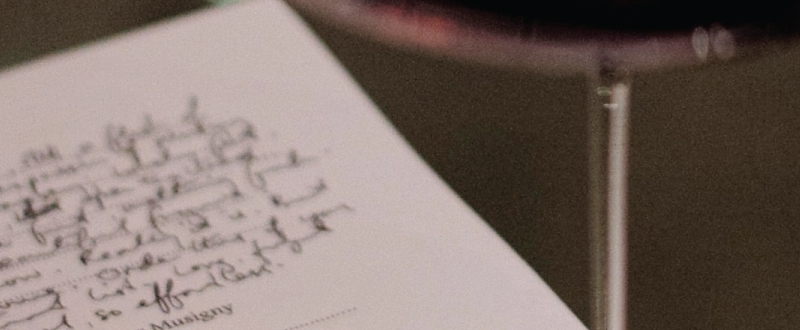
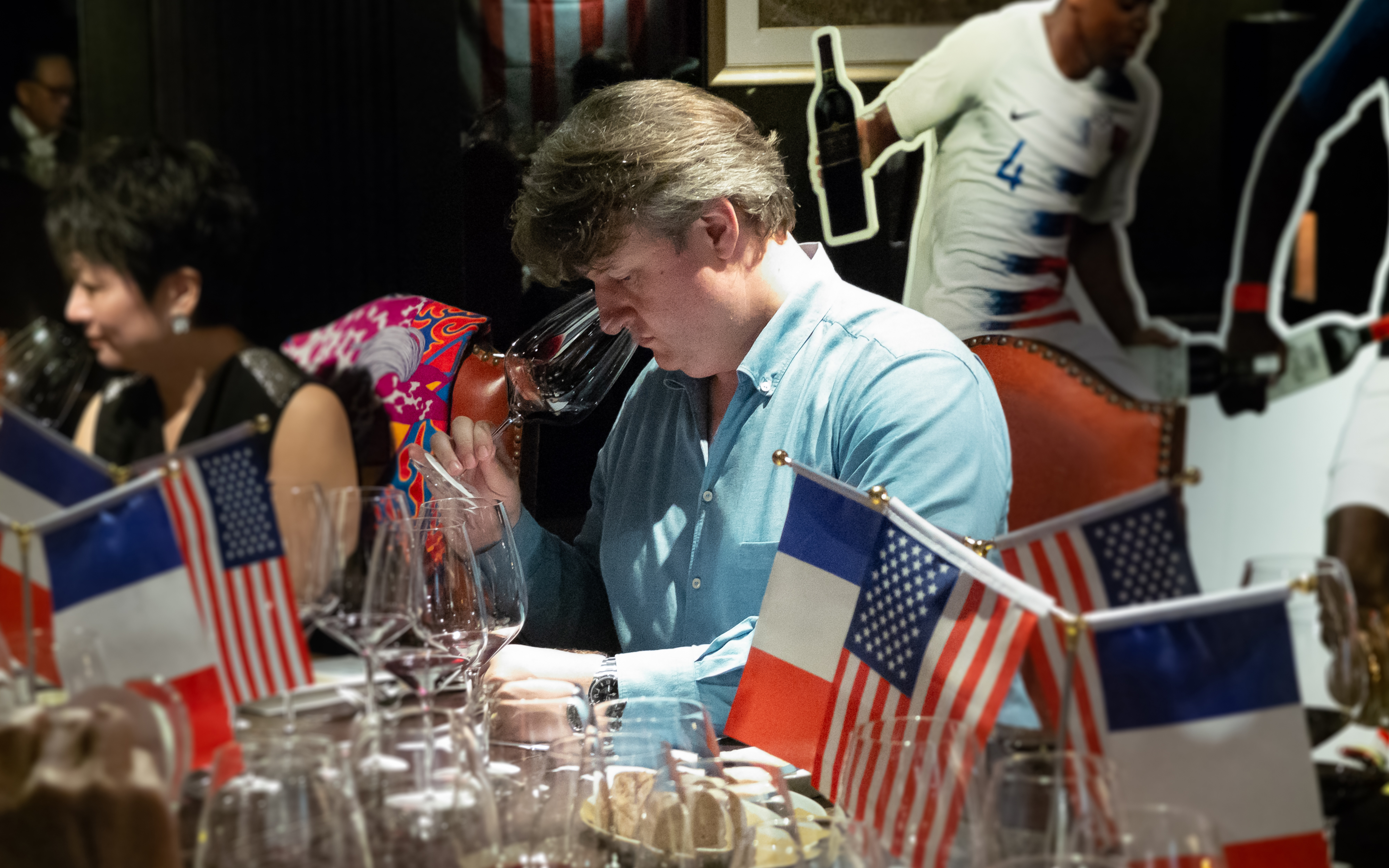
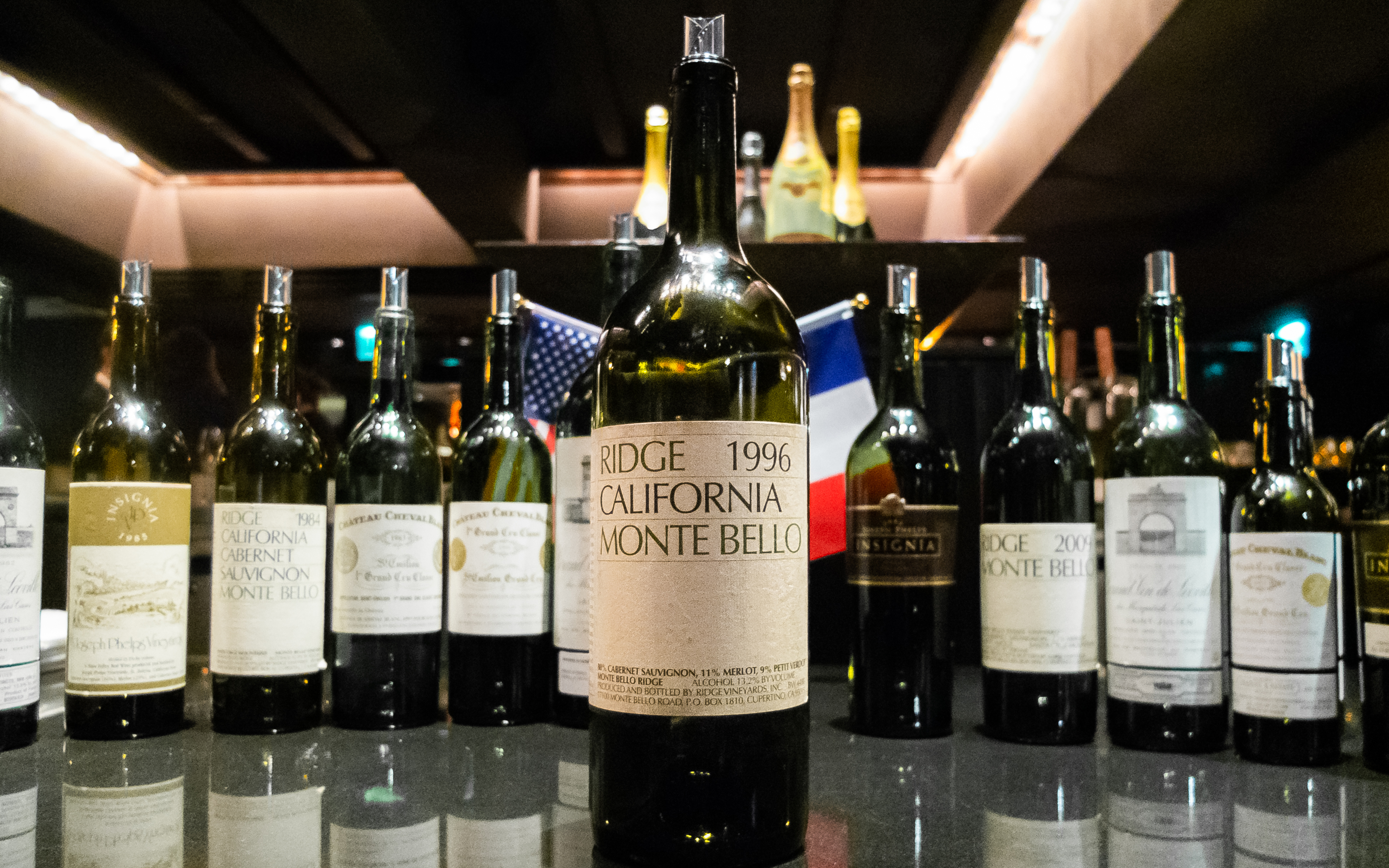

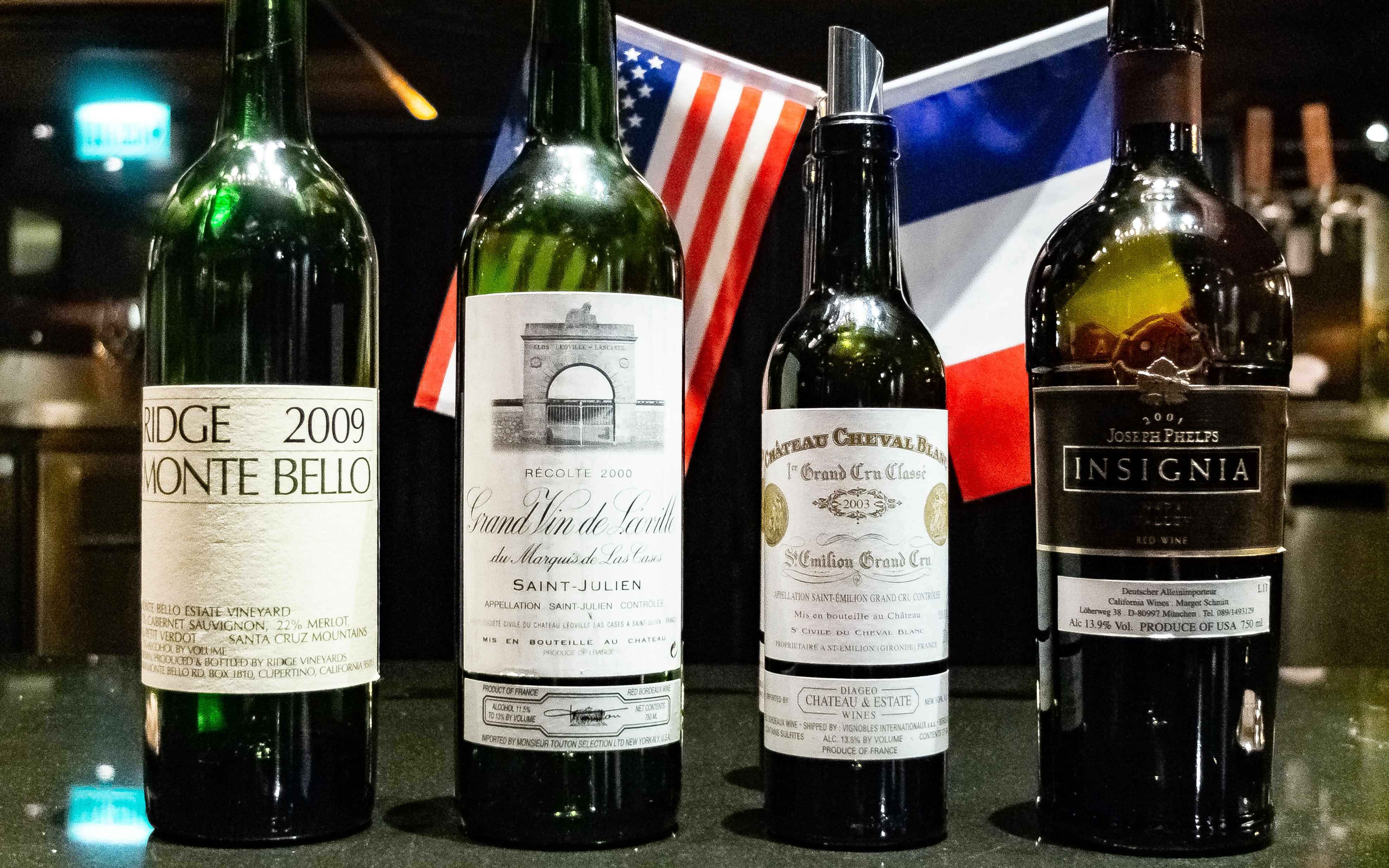
By Linden Wilkie
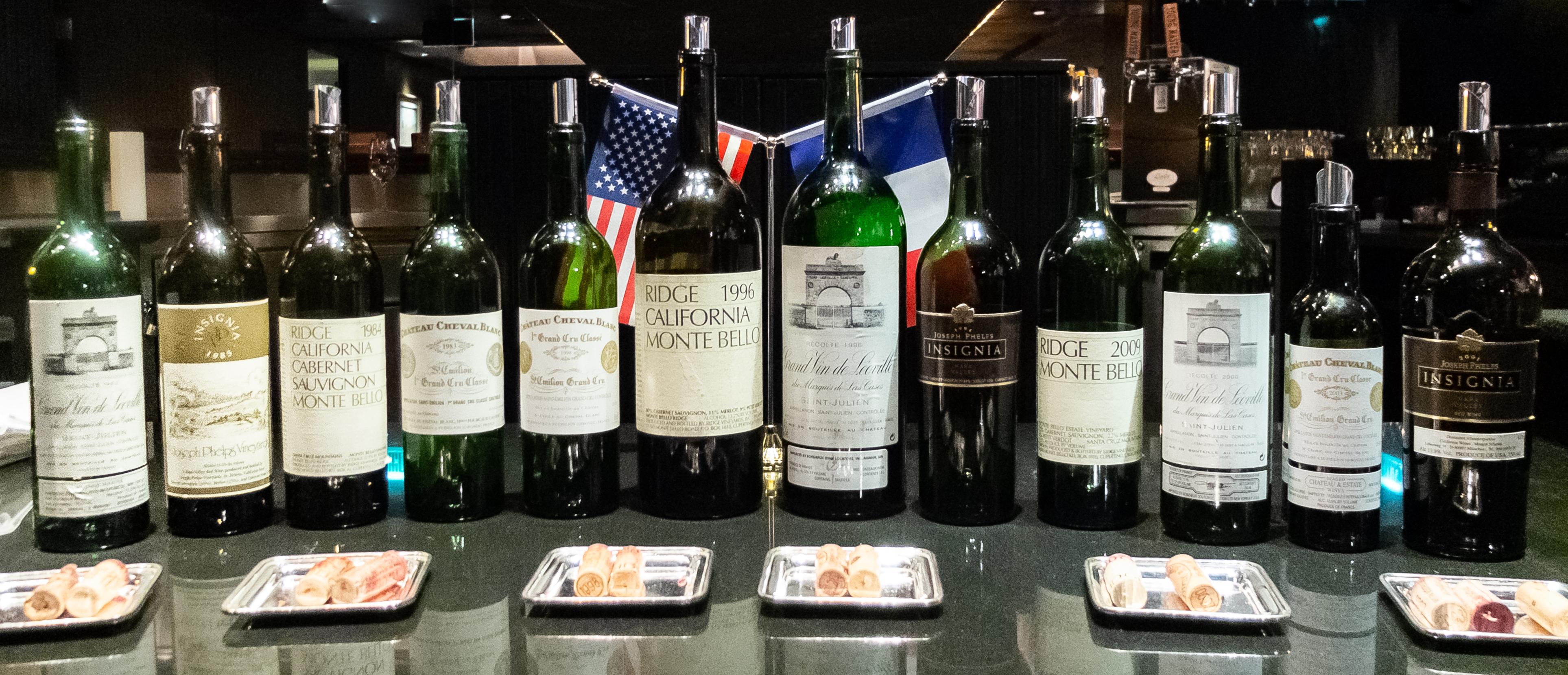
During the past four decades it’s become accepted wisdom that California can make Bordeaux-style reds to rival the home team. In 1976 this had come as a revelation in a blind tasting organized by the forward-thinking Steven Spurrier in Paris. The ‘Judgment of Paris’ as it became known saw largely French judges pick both a California white and a California red, trumping previously untouchable labels such as Batard-Montrachet or Château Haut-Brion.
What is notable about the original event is that all of the wine tasted were young vintages. None were older than 7 years of age, and most were 3~6. Some wines show well young, but in the realm of fine wine, further bottle age brings out full potential.
To that end, in 2009 I hosted a “Judgment of London” event pitting leading examples of reds from Bordeaux and California, and tasted blind in flights from the 1990s, 1980s and 1970s. In the 1970s flights, all of the wines were examples – and vintages – from the original Paris event – now of course all with a further 33 years in bottle. Steven Spurrier very kindly joined our group of 12 (6 Englishmen, and 6 ‘New World’ “judges”). In that event, the 1970s flight was won (again!) by California, while Bordeaux had clear wins in the 1980s and 1990s.
So tonight, almost a decade further along, we reprised the idea – the “Judgment of Hong Kong”, with flights from the 1980s, 1990s, and 2000s. The twist this time would be that in each flight, the producers would be the same – Ridge ‘Monte Bello’, and Joseph Phelps ‘Insignia’ representing California, and Château Léoville-Las Cases and Château Cheval Blanc representing
Bordeaux. In each case we hoped to select a vintage for each wine in which it performed well, relative to the decade. I think we mostly succeeded. We could split hairs...
Most of all what we sought was not so much a result, but a process of reflection – in a fun format – amongst our group of assembled ‘judges’ (open to any of our customers to sign up). Tasting blind of course makes us focus on what’s in the glass, rather than what’s on the label. We are all suggestible after all.
So, what did we learn, and what were the results?
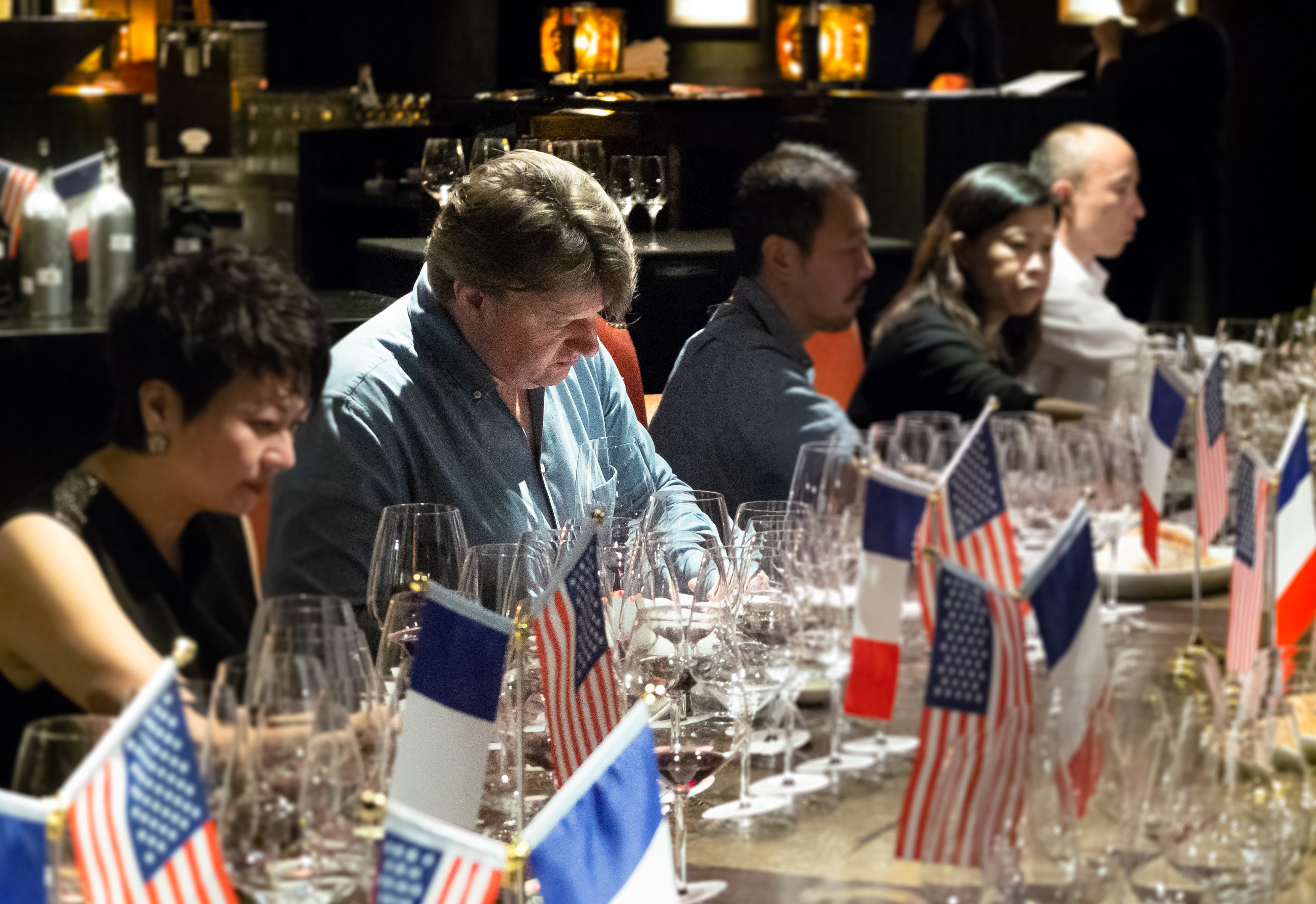
In the 1980s flight we see that our Californian selections struggled a bit in the face of true Bordeaux greatness. To my memory 1982 Las Cases has never failed me – it is a brilliant wine time and again, and still shows no signs of coming off its peak. The 1983 Cheval Blanc is not perfect – there is a touch of dryness, and next to the Las Cases, it doesn’t quite have an authoritive length on the finish. However, the fruit is enthralling, opulent and appealing and really unmistakable. The Phelps sits proudly apart as most certainly a Napa wine, and despite some similarities in my tasting note between it and the Cheval Blanc, they are quite different in fact – the cassis, mint and core depth of sweetness put the Phelps in its own category of style. In contrast, the Ridge seemed Medocain, except for its telltale American oak aroma.
For our group of judges it appears that Bordeaux trounced California in this first round, but when I look at my own notes and scores, the Las Cases aside, I thought the other three were qualitatively near par with one another. But to our panel, the results were far clearer than that. Below you will see my tasting notes and score for each wine, as well as its totality of points and placement in the flight.
I made the rules simple and as follows – rank the four wines in the flight from 1st place to 4th place. Scores were then tallied up (1 point for 1st, 2 points for 2nd, etc, and the lowest total score – like golf – wins). For interest, I’ve also included a little technical information on the wines.
1st place – (26pts) 1982 Château Léoville-Las Cases
2nd place – (28pts) 1983 Château Cheval Blanc
3rd place – (37pts) 1984 Ridge ‘Monte Bello’
4th place – (49pts) 1985 Joseph Phelps ‘Insignia’
Flight 1 – Wine 1
1982 Château Léoville-Las Cases 95
60% Cabernet Sauvignon, 26% Merlot, 9% Cabernet Franc, 5% Petit Verdot, 12.4% alcohol. Harvest 13th Sept – 29th Sept. Considered a great vintage.
Elegant and aromatic on the nose; supple and refined on the palate, with lovely acidity and very complex aromatic fruit. Tertiary development. A point in terms of readiness. Supple, yet still with lots of reserve. Léoville-Las Cases?
My top rank, the group’s top rank, the winner of the 1980s flight. 26 points.
Flight 1 – Wine 2
1985 Joseph Phelps ‘Insignia’ 92
60% Cabernet Sauvignon, 25% Merlot, 15% Cabernet Franc. 13 months in new and one use French oak puncheons and barrels. 13.5% alcohol. Considered a great vintage.
Sweet cassis and lift on the nose, with a touch of cocoa or melting chocolate; intense and concentrated on the palate, candied orange peel in chocolate with a touch of cassis, and a super minty edge. Insignia?
My fourth ranked wine, and the group’s fourth ranked wine. 49 points.
Flight 1 – Wine 3
1984 Ridge ‘Monte Bello’ 92+
93% Cabernet Sauvignon, 7% Merlot. 12.9% alcohol. Considered an excellent vintage.
Fine nose, candy-vanilla and red fruit, some cassis; elegant in a firm style with some grip, some mint, long finish. After a few minutes, I picked up an unmistakable whiff of American oak – pointing to Ridge Monte Bello. Good concentration, and drinking well.
My third ranked wine, and the group’s third ranked wine. 37 points.
Flight 1 – Wine 4
1983 Château Cheval Blanc 93
c50/50 Cabernet Franc / Merlot. 12.5% alcohol. A wetter but also hotter vintage than usual, saved by fine harvest conditions. Considered a success at Château Cheval Blanc.
A soaring nose of candied chocolate, orange, dust, spices galore – an exuberant nose; supple on the palate with a touch of dryness, but also so much candied fruit. Not the longest wine in the flight, but this has the wow! aromatics. Cheval Blanc?
My second ranked wine, the group’s second ranked wine. 28 points.
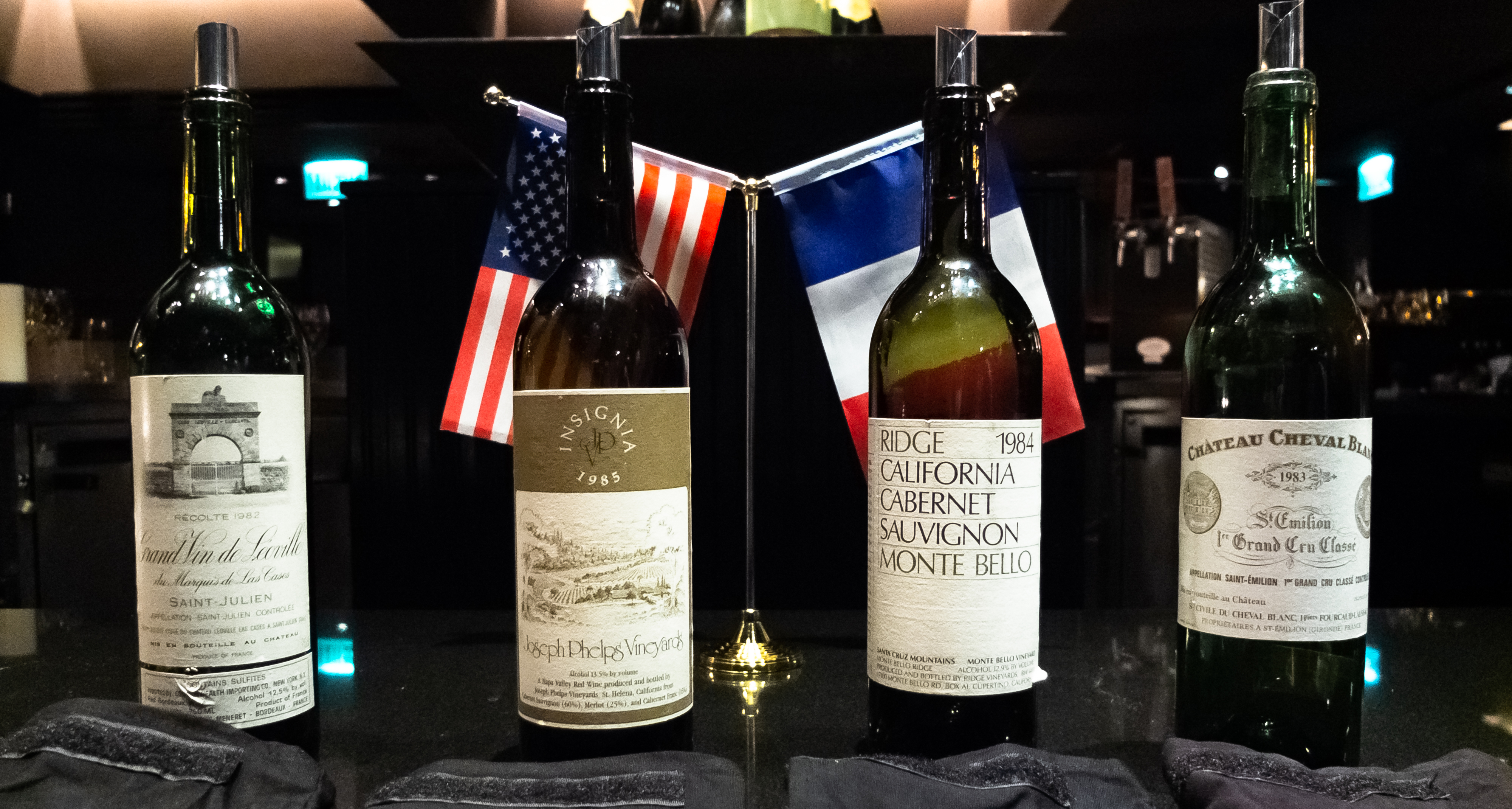
For the 1980s flight it took me a couple of tastes through but after that I was confident I knew which wine was which. Not so at all with the 1990s flight. I got there, but it took hard deductive concentration to figure it out. I wouldn’t have guessed that in advance – I expected a close call on quality, but I had anticipated an easy blind pick for the identities of these four iconic wines. After all, all four were on ‘home team’ vintages. The vintage 1998 produced the best Merlot on the Right Bank since 1964, and the late harvest in the Médoc in 1996 produced some of the most noble, elegant and long-tasting Cabernet in a long time too. In Napa, 1994 is one of the finest vintages, with superb depth and balance. By contrast, 1996 was more difficult for Ridge in Santa Cruz. Problems at flowering severely reduced potential yields, and summer was hot. The result – in my view – is spectacular.
Picking these wines out blind proved much more difficult than in the ‘80s flight, however. It was only when I ‘found’ the Insignia that I could really get to work on the other three. I ‘found’ the Las Cases, but only after concluding first that it was Cheval Blanc and then Monte Bello! What I finally figured out was the 1996 Monte Bello was for me the single most impressive bottle of the dinner. Whatever this turns out to be, I thought to myself, I’m going to buy some for myself!
Midway through the tasting of this flight, before we discussed anything, I said “not easy this flight, is it?” I got a fair amount of agreement. Someone ventured that he thought telling apart a California wine from a Bordeaux one would be easier than this.
In the end there was a clear winner for our panel in the 1990s flight – 1998 Château Cheval Blanc, a wine still barely beginning to unfurl from one of the Château’s greatest vin de garde years. Patience is still required here.
What was interesting was just how close the other three were – 37, 37, and 39 points. Virtually a tie. For me this was the most impressive flight, and I wouldn’t hesitate with any of them.
Stylistically, the Insignia still wore its heart on its sleeve, it is such a fun wine, and that is the impression it leaves. But this belies its impeccable balance, and sense of complexity and completeness. It is fine wine by any measure. I think the natural restraint and quality of the 1994 vintage suits it very well, and broadens its appeal beyond those who particularly like a ‘fruit bomb’ style.
1994 Insignia – 88% Cabernet Sauvignon, 10% Merlot, 2% Cabernet Franc : 69% estate, 31% growers. 22/9 – 18/10. 28 months new French oak. 13.5%
1st place – (27pts) 1998 Château Cheval Blanc
2nd= place – (37pts) 1996 Ridge ‘Monte Bello’
2nd= place – (37pts) 1994 Joseph Phelps ‘Insignia’
4th place – (39pts) 1996 Château Léoville-Las Cases
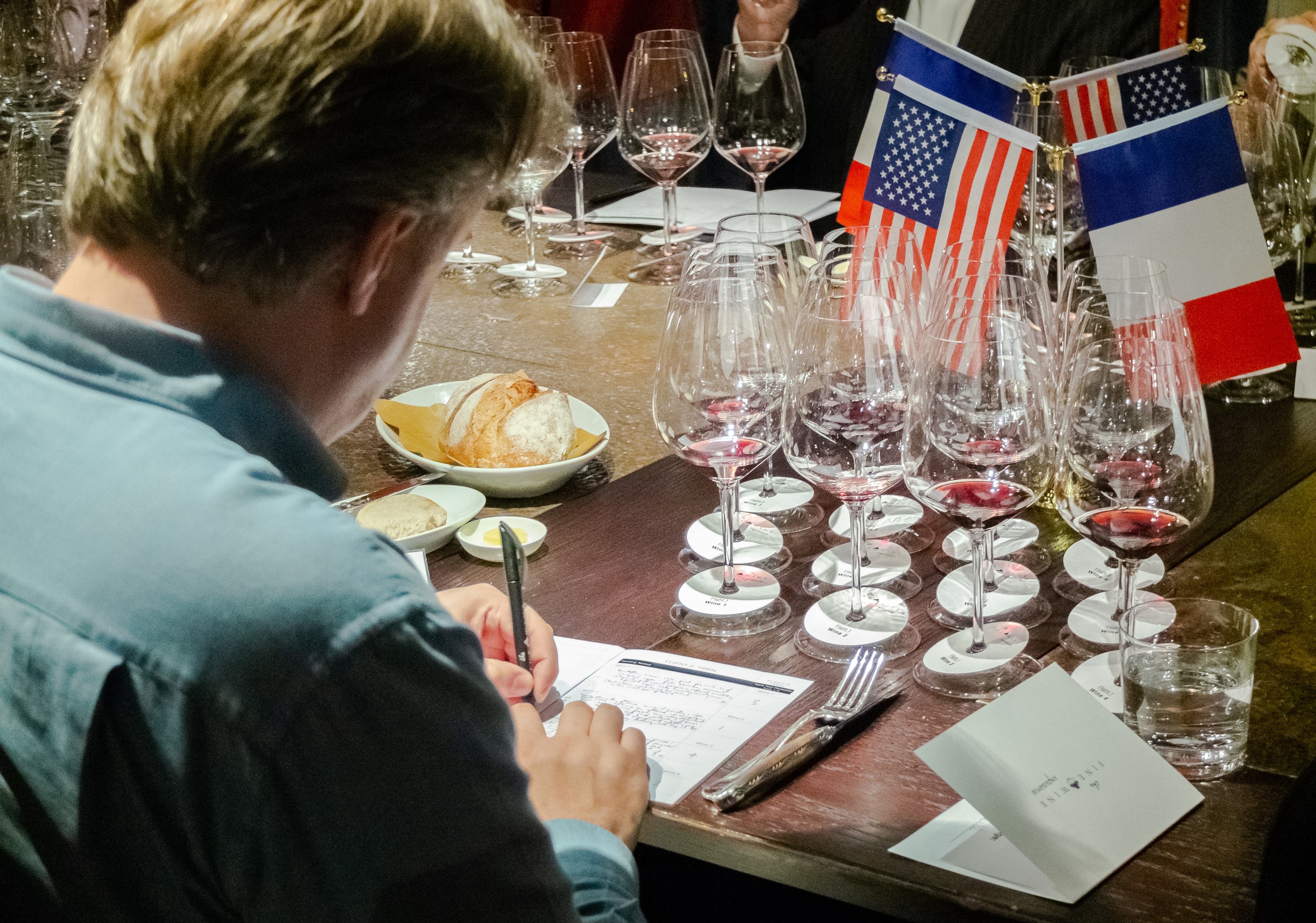
Flight 2 – Wine 1
1998 Château Cheval Blanc 95
56% Merlot, 44% Cabernet Franc. 13% alcohol. 100% new French oak. Harvest 21st Sept – 5th October. Considered a great vintage.
A beautifully classic nose, just-ripe Cabernet leafy notes, complex deep and open; fresh berries, mineral, elegant yet concentrated on the palate, gorgeous refined acidity and fruit, super long finish. There is just a hint of dryness, but not much. A lovely lovely wine.
My third ranked wine, the group’s top ranked wine. 27 points.
Flight 2 – Wine 2
1996 Ridge ‘Monte Bello’ 97
80% Cabernet Sauvignon, 11% Merlot, 9% Petit Verdot. 13.2% alcohol. A small but highly regarded vintage.
Some density of tone on the nose showing ripe fruit and a sweet/toasty biscuity note; intense on the attack with melting fruit and extract, concentrated, long and very detailed finish. This 1996 is still fairly young in expression, still just awakening. The tannins are super fine though they offer significant melting grip. This wine is so deep, creamy and fine. Largely hidden still, but top.
My top ranked wine, the group’s second-equal ranked wine. 37 points.
Flight 2 – Wine 3
1996 Château Léoville-Las Cases 93
70% Cabernet Sauvignon, 14% Merlot, 16% Cabernet Franc, 12.65% alcohol. 70% new oak.
Harvest 25th Sept – 10th October. A very fine, classic vintage, one of the best.
Fine clear fresh ruby colour; a reserved sweet nose at first; fine flesh, vibrant on the palate, just a touch of dryness/oak grain, but it dovetails into the fruit and natural acidity. It took time in the glass to open up, offering a melting glycerine richness. Overall elegant, refined, but not in the same league of complexity as wine 1 and wine 2.
My fourth ranked wine, the group’s fourth ranked wine. 39 points.
Flight 2 – Wine 4
1994 Joseph Phelps ‘Insignia’ 95
88% Cabernet Sauvignon, 10% Merlot, 2% Cabernet Franc. 13.5% alcohol. 28 months in new French oak barrels. Harvest 22nd Sept – 18th October.
A sweet nose of cherry compote and vanilla frosting; super fleshy on the palate, complex, layered fruit and mouthfeel, luxuriant and fun – a joyous sort of exuberance. No edges at all in this wine. Gorgeous.
My second ranked wine, the group’s second-equal ranked wine. 37 points.
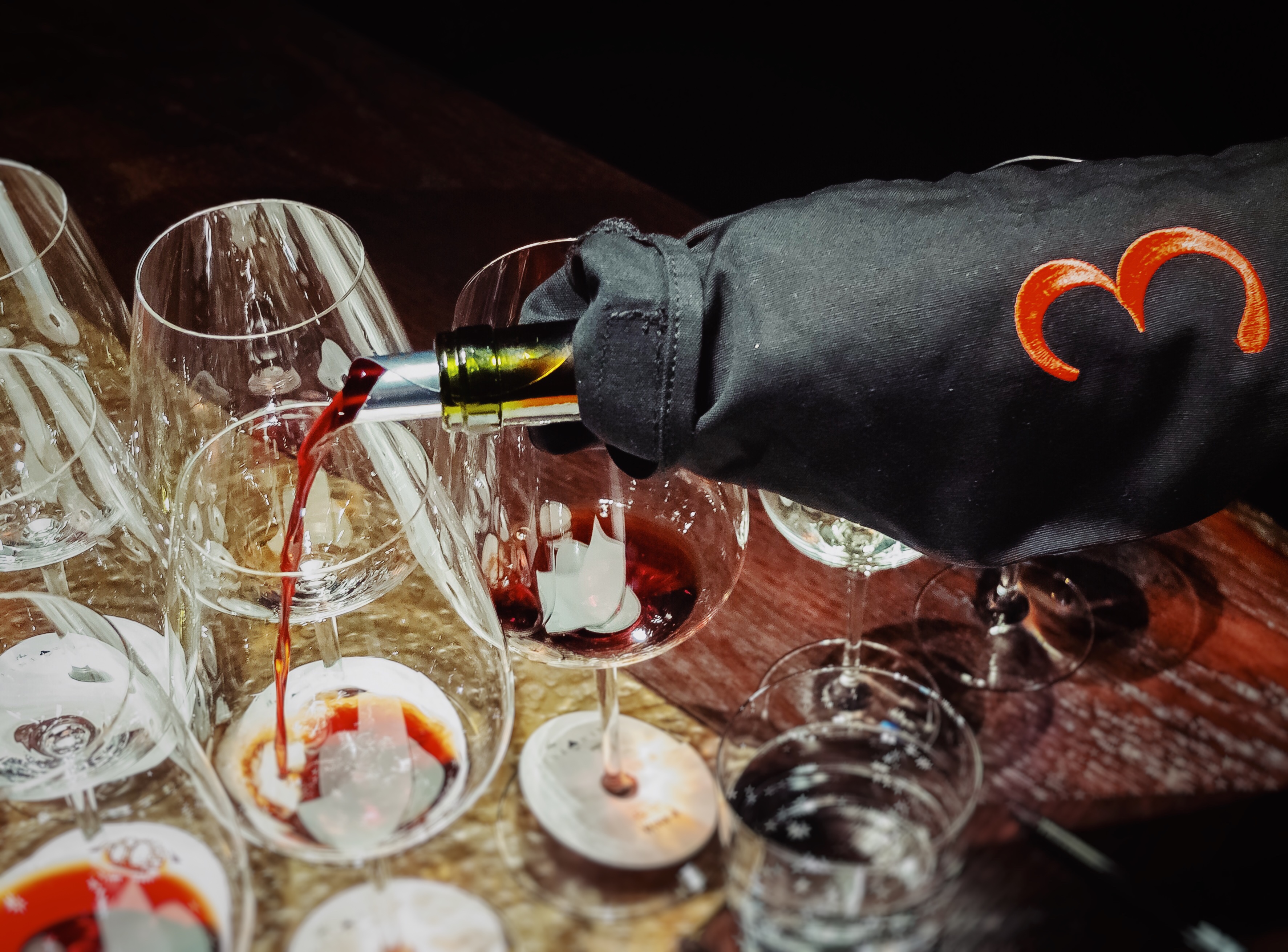
So, the 1990s and 1980s rounds went to France, though it should be noted that the gap closed from 54 v 86 in the 1980s round to 66 v 74 in the 1990s round. In the 2000s, the tables turned – 62 v 78 to California. The wine that sealed the deal in this round turned out to be the most popular wine of the whole night – 2009 Ridge Monte Bello, with just 25 points in its flight.
Again, it was necessary to taste carefully to identify each wine. Monte Bello in my mind sits closer to Léoville-Las Cases than Insignia in style, but give it a hot year and it can swing the other way to some extent – enough to ‘hide’ blind anyway. And I must confess that as easy as it should be to tell Léoville-Las Cases from Cheval Blanc, both give at least some of the aromatics you expect from Cabernet Franc (more leaf at Las Cases, more tea and spice at Cheval Blanc), and both can be firm (the ones we picked for the 1990s flight for example).
The Monte Bello win in this flight is interesting however. The cursory, throw away sort of conclusion is the stereotypical one – Bordeaux is for long ageing, while California Cabs are flattering when young. So it’s inevitable that California would win a flight devoted to younger vintages. But I’m not convinced by that here. First, both Bordeaux in this ‘young’ flight are already 15+ years old. Secondly, let’s give some credit to how mature the California fine wine craft now is. Paul Draper was convinced of the quality of Monte Bello, tasting the result of what its amateur (French sense of the word) owners had managed to produce with rudimentary knowledge and equipment in the few years since they began with the 1962. (In 2009 I tasted one of these – the 1964 – still good then). Draper began c1968, so by the time he made this 2009 he had over 40 vintages under his belt. The vines were older, and the science – both in the vineyard and the winery – was better, more fine-tuned. There is a point at which a great terroir and a great team outweigh the relative differences between decades of experience and centuries of experience! Ridge is a fine example of that.
1st place – (25pts) 2009 Ridge ‘Monte Bello’
2nd= place – (37pts) 2000 Château Léoville-Las Cases
2nd= place – (37pts) 2001 Joseph Phelps ‘Insignia’
4th place – (39pts) 2003 Château Cheval Blanc
Flight 3 – Wine 1
2009 Ridge ‘Monte Bello’ 93
72% Cabernet Sauvignon, 22% Merlot, 6% Petit Verdot. 13.5% alcohol. Harvest 23rd Sept to 12th October. 97% new and 1% one year American oak ; 2% new French oak (for comparison). 19 months in barrel. A year with a short growing season but a good reputation.
Fine, clear, deep; a sweet, up front aroma, spicy and bright, and complex juicy-creamy expression; lush on the palate, melting yet fresh, super quality of fruit, fine texture, supple, long. There’s a touch of oak and oak-graininess in the tannins, but overall this is the most cuddly wine in the flight. I initially thought it might have been the Insignia, until I tasted the fourth wine.
My top ranked wine, the group’s top ranked wine. 25 points.
Flight 3 – Wine 2
2000 Château Léoville-Las Cases 92+
77% Cabernet Sauvignon, 9% Merlot, 14% Cabernet Franc. 12.75% alcohol. 28th Sept – 11th October. A year with a uniformally high reputation in Bordeaux. Considered a great year for this property.
A fresh colour, still a hint of blue tone to the ruby; a sweet open nose, confit berry, a hint of marzipan and cocoa; fleshy and lush on the palate, melting, vibrantly fresh and refined in style, elegantly-fruity. The oak texture lets it down a little, but this is elegantly fruity and lovely.
My second ranked wine, the group’s second-equal ranked wine. 37 points.
Flight 3 – Wine 3
2003 Château Cheval Blanc 92
56% Cabernet Franc, 44% Merlot. 13.5% alcohol. A difficult vintage due to heat and drought, resulting in an early harvest – 1st to 18th September. A very good if atypical reputation.
Clear ruby – lighter tone ; decadently sweet ripe nose, spicy, confit fruit with a candied edge ; lush, fleshy, real depth and there is some grip on the finish, but oh so much effortless extract. A touch of dark chocolate on the finish.
My third ranked wine, the group’s fourth ranked wine. 41 points.
Flight 3 – Wine 4
2001 Joseph Phelps ‘Insignia’ 91
89% Cabernet Sauvignon, 8% Petit Verdot, 3% Malbec. 13.9% alcohol. Harvest 5th Sept – 13th October. 23 months in new French oak barrels. A balanced vintage with a super high reputation for Joseph Phelps ‘Insignia’.
Deep, fresh ruby; a fine nose, ripe but with a cool expression – just lovely fruit; lush, fleshy, cuddly but fresh in expression, well- balanced, cocoa-laced throughout. Beautifully made, heady, lush and long. Some oaky sweetness and candy at the end. The nose here belies the decadence that follows on the palate. The finish is a touch hot.
My fourth ranked wine, the group’s second-equal ranked wine. 37 points.
So, in the end the French won it (and right on the heels of their Football World Cup victory just a week before. Allez les Bleus!
Before however we jump to “see, of course!” conclusions on  one hand, or “but it was biased / scientifically invalid!” on the other, let me be the first to say this was never intended to allow us to conclude whether California makes better wine than Bordeaux, or vice versa. The answer to that – to me – is not what’s especially interesting here (as much as it is a fun way to taste). We’d have to taste a lot of wine in one sitting to leave the statisticians comfortable in their seats. Which would get us to the question of methodology. Which would leave us the question of the make up of the judging panel… etc! Even then, as Spurrier is quoted to have commented on his own 1976 competition, “The results of a blind tasting cannot be predicted and will not even be reproduced the next day by the same panel tasting the same wines.” Absolutely.
one hand, or “but it was biased / scientifically invalid!” on the other, let me be the first to say this was never intended to allow us to conclude whether California makes better wine than Bordeaux, or vice versa. The answer to that – to me – is not what’s especially interesting here (as much as it is a fun way to taste). We’d have to taste a lot of wine in one sitting to leave the statisticians comfortable in their seats. Which would get us to the question of methodology. Which would leave us the question of the make up of the judging panel… etc! Even then, as Spurrier is quoted to have commented on his own 1976 competition, “The results of a blind tasting cannot be predicted and will not even be reproduced the next day by the same panel tasting the same wines.” Absolutely.
What I think we can conclude from this little bit of fun in Hong Kong, in homage to Spurrier’s landmark event 42 years earlier, is that the best Bordeaux varietal reds from California sit in the same league as the best Bordeaux reds. There are differences in fruit, texture, and flavour, but those differences can be exaggerated in our minds compared to what we fine in the glass. So, I declare my ulterior motive here – if you know and love Bordeaux, but haven’t also explored California, you are missing out.
